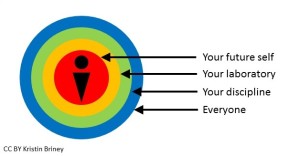
I was at OpenCon last week and left with lots of ideas about being open. In particular, my general understanding of open broadened to thinking about: open is really just a means to other things, the necessity of advocacy, and that improved access and data literacy needs to go hand-in-hand with opening up data. I still have a lot to process but I wanted to blog about one issue that I sketchnoted (right) during the “Open Data Brainstorming” unconference session: the many layers of opening up data.
The point is this: that Open Data doesn’t have to be an all-or-nothing thing. This idea doesn’t really align with the big goals of OpenCon, but I think a layered approach to Open Data is very practical for those researchers who aren’t used to sharing data.
Instead of making your data totally open or totally closed, it might be better to think of the following layers of openness:
- Making data usable for yourself
- Making data usable for your future self
- Making data usable for your coworkers/boss
- Making data usable for your discipline
- Making data usable for everyone

While the last layer is the ultimate goal of “Open Data”, I definitely think that there is value in the inner layers. For example, even if your data isn’t totally open, it can be of huge benefit for your data to be usable to your coworkers/boss instead of just yourself. The other reason that this model works is that data tailored for one layer is not automatically usable in the next layer out – though the reverse is usually true!
A related idea, and one that I’ve already blogged about, is the hidden cost of Open Data. (Basically, Open Data takes work but data management makes it easier to put your data in a form ready to be used by other people.) But if we think about Open Data in a layered approach, the cost comes in stages rather than all at once.
So instead of saying, “you must make your data totally open”, I instead challenge you to move a layer out. For example, are you terrible at data management? Try making data more useful to your future self. Can your coworkers/boss understand and use your data? Put practices into place to make that data usable to others in your field. Each of these steps outward brings concrete benefit to yourself and others.
I really think that Open Data can be a layered process. Not only does this help us recognize the work that open requires but can help bring those unused to sharing on board with the idea of Open Data.




